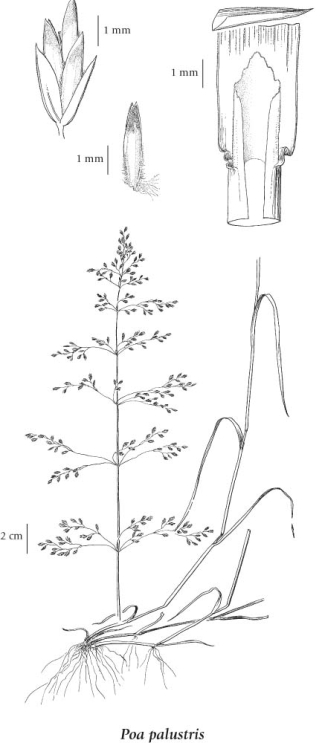Poa palustris L.
fowl bluegrass
Poaceae (Grass family)
Introduction to Vascular Plants
fowl bluegrass
Poaceae (Grass family)
Introduction to Vascular Plants
Species Information
General:
Perennial, densely to loosely tufted grass from fibrous roots, sometimes with stolons; stems erect or decumbent, 25-120 cm tall/long, some branching above base, uppermost node above middle.
Leaves:
Top stem blade to sheath length ratio mostly 0.5-1.31; terminal sheath (3.3) 7-20 cm long, margins open 4/5 or more their length; sterile shoots all or most flowering within a season, next year's shoots set late in the growing season, breaking through sheath bases with indistinct two-keeled buds protecting the scales; shoots arising inside sheaths frequently present; basal leaves bladeless; blades 1.5-8 mm wide, mostly flat, often lax; ligules (1) 1.5-6 mm long, the tips rounded to sharp-pointed, frequently jagged, the backs sparsely to distinctly rough.
Flowers:
Inflorescence a lax panicle, (10) 15-30 (40) cm long, sparse to moderately congested, eventually open, highly branched with many spikelets, the branches 2 to 9 per node, initially appressed, eventually widely spreading to slightly reflexed, distinctly rough on angles, the stalks shortly exserted; spikelets laterally compressed, 3-5 mm long, (1-) 2- to 5-flowered; lower glumes 3-nerved; rachilla internodes mostly less than 1 mm long, smooth, minutely bumpy, or sparsely short straight-hairy, not silky or minutely soft-hairy; lemmas lanceolate, 2-3 mm long, the tips usually bronze-coloured in part, sharp-pointed, the keels and marginal nerves short silky-hairy, hairless between the nerves, the tips frequently incurved and blunt; calluses sparsely to moderately densely cobwebby; palea keels rough; flowers bisexual; anthers 1.3-1.8 mm long.
Illustration

If more than one illustration is available for a species (e.g., separate illustrations were provided for two subspecies) then links to the separate images will be provided below. Note that individual subspecies or varietal illustrations are not always available.
Illustration Source: The Illustrated Flora of British Columbia
USDA Species Characteristics
Flower Colour:
Yellow
Blooming Period:
Mid Spring
Fruit/Seed characteristics:
Colour: Brown
Present from Spring to Summer
Source: The USDA
Ecology
Ecological Framework for Poa palustris
The table below shows the species-specific information calculated from
original data (BEC database) provided by the BC Ministry of Forests and Range.
(Updated August, 2013)
The table below shows the species-specific information calculated from
original data (BEC database) provided by the BC Ministry of Forests and Range.
(Updated August, 2013)
| Site Information |
Value / Class |
||
|
Avg |
Min |
Max |
|
| Elevation
(metres) |
946 | 1 | 2410 |
| Slope
Gradient (%) |
9 | 0 | 85 |
|
Aspect (degrees) |
195 | 2 | 360 |
| Soil
Moisture Regime (SMR) [0 - very xeric; 4 - mesic; 8 - hydric] |
5 | 0 | 8 |
| Modal
Nutrient Regime
Class |
D | ||
| #
of field plots species was recorded in: |
402 | ||
| Modal
BEC Zone Class |
SBS | ||
|
All BEC Zones (# of stations/zone) species was recorded in |
AT(2), BG(12), BWBS(27), CDF(22), CMA(1), CWH(48), ESSF(46), ICH(25), IDF(63), MH(2), MS(21), PP(7), SBPS(30), SBS(67), SWB(10) | ||
|
Source:
Klinkenberg 2013
|
|||
Habitat and Range
Wet to moist disturbed areas, meadows, ditches, shrublands and riparian sites in the lowland and montane zones; frequent in S and W BC; circumboreal, N to AK, YT and NT, E to NF and S to ME, NY, SC, TN, MS, NE, NM, AZ and CA; Eurasia.Status Information
Synonyms
Synonyms and Alternate Names:
Poa crocata Michx.
Poa eyerdamii Hultén
Poa triflora Gilib.